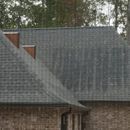Roof shingle condensation
I have a question about some top of shingle condensation that I’m seeing on my garage (see picture).
The space is not heated or cooled, other than what mother nature does. It is however fully insulated, both walls and ceiling. The area where you see that condensation is cathedral, where the condensation stops is at the collar ties where the cathedral section also ends. There is a continuous soffit vent and the upper ridge vent.
The insulation is fiberglass batt insulation, they were supposed to use baffles in that space but I’m not sure they did not simply use 8″ insulation on 12″ rafters, leaving an air gap. I don’t see any moisture inside, just on the roof exterior, mostly on the area that gets the most sun during the day and last sun in the evening.
Is this just normal now that we are getting cool evenings or should I be looking for a potential issue? Thanks for your advice.
GBA Detail Library
A collection of one thousand construction details organized by climate and house part










Replies
Hi Stephen,
Are you noticing this in the morning? And just now that the weather is changing? If so, I would think that you entire roof is getting some dew on it overnight and this area of the roof is drying more slowly in the morning because of the details of the the assembly below. That doesn't necessarily mean that there is a problem inside of the roof. I'll be curious to see what some others think.
The sections with the condensation are where the insulation is working. Where it's dry the interior side is warmer or more thermally conductive (like the rafter-striping), or the interior side is pretty much the same temperature as the top surface (as in the overhangs or vented ridge-attic.)
I suspect the heat retention of the brick veneer is keeping the overhangs from dropping below the dew point. There may or may not be a heat leak into the ridge zone.
Bottom line, it looks pretty much the way it should, based on the description.
Sometimes there are trees or buildings re-radiating heat back to the roof on one side or another, which keeps the roof deck a bit closer to or slightly above the outdoor air's dew point. The more sky-exposure, the colder the roofing is, and the more likely it is to hit the dew point on clear cool nights.